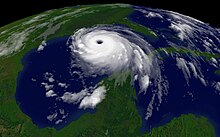| Part of Hurricane Katrina | |
 | |
 |
| Hurricane Katrina |
|---|
 |
| 2005 Atlantic hurricane season |
| General |
| Impact |
| Relief |
| Analysis |
| External links |
|
Criticism of the government response to Hurricane Katrina[1] was a major political dispute in the United States in 2005 that consisted primarily of condemnations of mismanagement and lack of preparation in the relief effort in response to Hurricane Katrina and its aftermath. Specifically, there was a delayed response to the flooding of New Orleans, Louisiana. (See Hurricane preparedness in New Orleans for criticism of the failure of Federal flood protection.)
Within days of Katrina's August 29, 2005 landfall, public debate arose about the local, state, and federal governments' role in the preparations for and response to the storm. Criticism was prompted largely by televised images of visibly shaken and frustrated political leaders, and of residents who remained in New Orleans without water, food or shelter and the deaths of several citizens by thirst, exhaustion, and violence, days after the storm itself had passed.[citation needed] The treatment of people who had evacuated to registered facilities such as the Superdome was also criticized.[2]
Criticism from politicians, activists, pundits, and journalists of all stripes has been directed at the local, state, and federal governments.
New Orleans Mayor Ray Nagin was also criticized for failing to implement his flood plan and for ordering residents to a shelter of last resort without any provisions for food, water, security, or sanitary conditions. Perhaps the most important criticism of Nagin is that he delayed his emergency evacuation order until less than a day before landfall, which led to hundreds of deaths of people who (by that time) could not find any way out of the city.[3] Adding to the criticism was the broadcast of school bus parking lots full of baby blue school buses, which Mayor Nagin refused to be used in evacuation. When asked why the buses were not used to assist evacuations instead of holing up in the Superdome, Nagin cited the lack of insurance liability and shortage of bus drivers.[4]
New Orleans has been classified as a non-regime city. Regimes involve governmental and non-governmental cooperation, a specific agenda, a recognized problem, and resources to deal with the problem. New Orleans only had a temporary coalition to deal with Hurricane Katrina, which led to the ineffective, temporary, and inefficient evacuation and provision of resources. Organizations such as the Red Cross attempted to form coalitions, but the various actors could not agree on a specific solution, and this failure to cooperate led to instability and misunderstanding between governmental and non-governmental actors.[5]
- ^ "Katrinagate fury spreads to US media". Television New Zealand. 2005-09-07. Retrieved 2007-06-04.
- ^ "HURRICANE KATRINA A NATION STILL UNPREPARED" (PDF).
- ^ "Select Bipartisan Committee to Investigate the Preparation for and Response to Hurricane Katrina (February 15, 2006). "A Failure of Initiative: Final Report of the Select Bipartisan Committee to Investigate the Preparation for and Response to Hurricane Katrina" (PDF). U.S. Government Publishing Office. Retrieved July 30, 2015.
- ^ Frontline: The Storm
- ^ Burns, P.; Thomas, M.. "The Failure of the Nonregime: How Katrina exposed New Orleans as a Regimeless City". Urban Affairs Review 41 (4): 517-527.
© MMXXIII Rich X Search. We shall prevail. All rights reserved. Rich X Search
